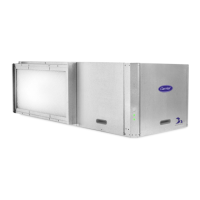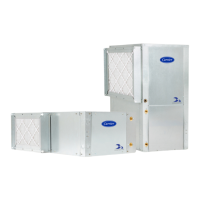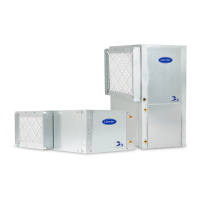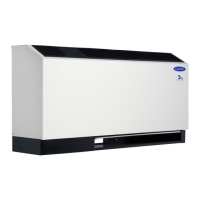37
Table 6 — 50HQP,VQP Typical Unit Operating Pressures and Temperatures (cont)
Flow Regulation
Flow regulation can be accomplished by two methods. Most water
control valves have a flow adjustment built into the valve. By
measuring the pressure drop through the unit heat exchanger, the
flow rate can be determined. Adjust the water control valve until
the flow of 1.5 to 2 gpm is achieved. Since the pressure constantly
varies, two pressure gages may be needed in some applications.
An alternative method is to install a flow control device. These
devices are typically an orifice of plastic material designed to al-
low a specified flow rate that are mounted on the outlet of the wa-
ter control valve. Occasionally these valves produce a velocity
noise that can be reduced by applying some back pressure. To ac-
complish this, slightly close the leaving isolation valve of the well
water setup.
Flushing
Once the piping is complete, final purging and loop charging is
needed. A flush cart pump of at least 1.5 hp is needed to achieve
adequate flow velocity in the loop to purge air and dirt particles
from the loop. Flush the loop in both directions with a high vol-
ume of water at a high velocity. Follow the steps below to properly
flush the loop:
1. Verify power is off.
2. Fill loop with water from hose through flush cart before
using flush cart pump to ensure an even fill. Do not allow
the water level in the flush cart tank to drop below the
pump inlet line to prevent air from filling the line.
3. Maintain a fluid level in the tank above the return tee to
avoid air entering back into the fluid.
4. Shutting off the return valve that connects into the flush
cart reservoir will allow 50 psig surges to help purge air
pockets. This maintains the pump at 50 psig.
5. To purge, keep the pump at 50 psig until maximum pump-
ing pressure is reached.
6. Open the return valve to send a pressure surge through the
loop to purge any air pockets in the piping system.
7. A noticeable drop in fluid level will be seen in the flush
cart tank. This is the only indication of air in the loop.
NOTE: If air is purged from the system while using a 10 in. PVC
flush tank, only a 1 to 2 in. level drop will be noticed since liquids
are incompressible. If the level drops more than this, flushing
should continue since air is still being compressed in the loop. If
level is less than 1 to 2 in., reverse the flow.
1. Repeat this procedure until all air is purged.
2. Restore power.
Antifreeze may be added before, during or after the flushing pro-
cess. However, depending on when it is added in the process, it
can be wasted. Refer to the Antifreeze section for more detail.
Loop static pressure will fluctuate with the seasons. Pressures will
be higher in the winter months than during the warmer months.
This fluctuation is normal and should be considered when
charging the system initially. Run the unit in either heating or cool-
ing for several minutes to condition the loop to a homogenous
temperature.
When complete, perform a final flush and pressurize the loop to a
static pressure of 40 to 50 psig for winter months or 15 to 20 psig
for summer months.
50HQP,
50VQP
UNIT
SIZE
ENTERING
WATER
TEMP
(F)
WATER
FLOW
(GPM/ton)
COOLING HEATING
Suction
Pressure
(psig)
Discharge
Pressure
(psig)
Water
Temp
Rise
(F)
Air Temp
Drop
(F) DB
Suction
Pressure
(psig)
Discharge
Pressure
(psig)
Water
Temp
Drop
(F)
Air
Temp
Rise
(F) DB
300
30
45.0 — — — — 68- 84 256-313 5- 7 19-23
75.0 — — — — 73- 89 261-319 4- 5 20-25
40
45.0 117-143 210-256 15-19 21-26 81- 99 277-339 7- 8 22-26
75.0 114-139 196-239 11-14 22-27 86-105 283-346 5- 6 23-28
50
45.0 120-147 243-297 15-18 20-25 93-114 299-365 8- 9 24-29
75.0 117-143 227-277 11-14 21-26 99-121 305-373 6- 7 25-31
60
45.0 123-150 276-337 14-17 20-24 106-129 321-392 9-11 26-32
75.0 119-146 258-315 11-13 21-25 113-138 327-400 7- 8 28-34
70
45.0 126-154 309-378 14-17 19-24 118-145 342-418 10-12 29-35
75.0 122-149 289-353 10-13 20-25 126-154 349-427 8- 9 30-37
80
45.0 129-157 343-419 13-16 19-23 131-160 364-444 11-14 31-38
75.0 125-153 320-391 10-12 19-24 139-170 371-454 8-10 33-40
90
45.0 132-161 376-459 13-16 18-22 143-175 385-471 12-15 33-41
75.0 128-156 351-429 10-12 19-23 152-186 393-480 9-11 35-43
100
45.0 134-164 409-500 12-15 17-21 — — — —
75.0 131-160 382-
467 9-11 18-22 — — — —
360
30
50.0 — — — — 65- 80 282-344 6- 7 14-17
90.0 — — — — 73- 89 294-359 3- 4 15-18
40
50.0 121-148 184-225 17-21 18-22 80- 98 299-365 7- 9 16-20
90.0 117-143 167-204 10-13 19-23 89-108 311-380 4- 5 17-21
50
50.0 123-151 222-271 17-20 17-21 95-116 315-385 9-11 19-23
90.0 119-145 202-247 10-12 18-23 105-128 329-402 5- 7 20-24
60
50.0 125-153 260-318 16-19 17-21 109-133 332-406 11-13 21-26
90.0 120-147 237-289 10-12 18-22 121-148 346-423 6- 8 22-27
70
50.0 127-155 298-365 15-19 17-20 124-151 349-427 12-15 23-28
90.0 122-149 271-331 9-11 18-21 138-168 364-444 7- 9 25-30
80
50.0 129-158 336-411 14-18 16-20 138-169 366-447 14-17 26-31
90.0 124-152 306-374 9-11 17-21 154-188 381-466 8-10 27-33
90
50.0 131-160 374-458 14-17 16-19 153-187 383-468 16-19 28-34
90.0 126-154 340-416 8-10 17-20 170-208 399-487 9-12 29-36
100
50.0 133-162 413-504 13-16 15-19 — — — —
90.0 128-156 375
-458 8-10 16-20 — — — —
WARNING
To avoid possible injury or death due to electrical shock, open
the power supply disconnect switch and secure it in an open
position before flushing system.
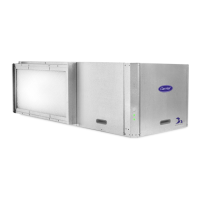
